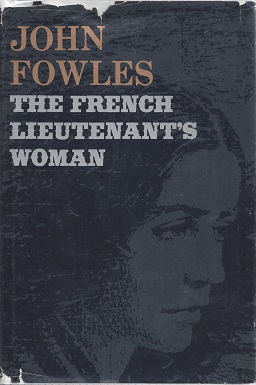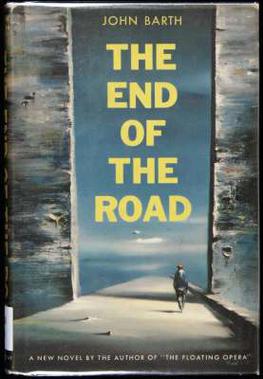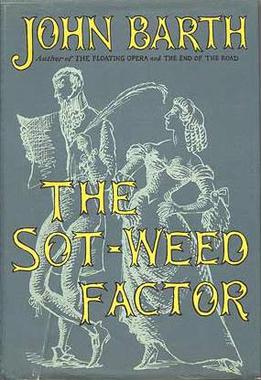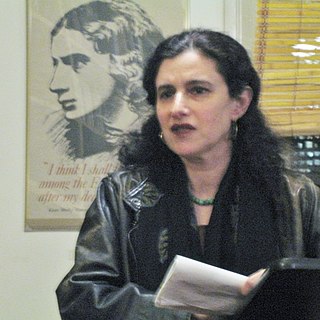
The French Lieutenant's Woman is a 1969 postmodern historical fiction novel by John Fowles. The plot explores the fraught relationship of gentleman and amateur naturalist Charles Smithson and Sarah Woodruff, the former governess and independent woman with whom he falls in love. The novel builds on Fowles' authority in Victorian literature, both following and critiquing many of the conventions of period novels.
Metafiction is a form of fiction that emphasizes its own narrative structure in a way that inherently reminds the audience that they are reading or viewing a fictional work. Metafiction is self-conscious about language, literary form, and story-telling, and works of metafiction directly or indirectly draw attention to their status as artifacts. Metafiction is frequently used as a form of parody or a tool to undermine literary conventions and explore the relationship between literature and reality, life, and art.

John Simmons Barth was an American writer best known for his postmodern and metafictional fiction. His most highly regarded and influential works were published in the 1960s, and include The Sot-Weed Factor, a whimsical retelling of Maryland's colonial history; Giles Goat-Boy, a satirical fantasy in which a university is a microcosm of the Cold War world; and Lost in the Funhouse, a self-referential and experimental collection of short stories. He was co-recipient of the National Book Award in 1973 for his episodic novel Chimera.

Postmodern literature is a form of literature that is characterized by the use of metafiction, unreliable narration, self-reflexivity, intertextuality, and which often thematizes both historical and political issues. This style of experimental literature emerged strongly in the United States in the 1960s through the writings of authors such as Kurt Vonnegut, Thomas Pynchon, William Gaddis, Philip K. Dick, Kathy Acker, and John Barth. Postmodernists often challenge authorities, which has been seen as a symptom of the fact that this style of literature first emerged in the context of political tendencies in the 1960s. This inspiration is, among other things, seen through how postmodern literature is highly self-reflexive about the political issues it speaks to.

Giles Goat-Boy (1966) is the fourth novel by American writer John Barth. It is a metafictional comic novel in which the universe is portrayed as a university campus in an elaborate allegory of both the hero's journey and the Cold War. Its title character is a human boy raised as a goat, who comes to believe he is the Grand Tutor, the predicted Messiah. The book was a surprise bestseller for the previously obscure Barth, and in the 1960s had a cult status. It marks Barth's leap into American postmodern fabulism.
Historiographic metafiction is a term coined by Canadian literary theorist Linda Hutcheon in the late 1980s. It incorporates three domains: fiction, history, and theory.
The slipstream genre is a term denoting forms of speculative fiction that blends together science fiction, fantasy, and literary fiction or do not remain in conventional boundaries of genre and narrative. It directly extends from the experimentation of the New Wave science fiction movement while also borrowing from fantasy, psychological fiction, philosophical fiction and other genres or styles of literature.

The End of the Road is the second novel by American writer John Barth, published first in 1958, and then in a revised edition in 1967. The irony-laden black comedy's protagonist Jacob Horner suffers from a nihilistic paralysis he calls "cosmopsis"—an inability to choose a course of action from all possibilities. As part of a schedule of unorthodox therapies, Horner's nameless Doctor has him take a teaching job at a local teachers' college. There Horner befriends the super-rational Joe Morgan and his wife Rennie. The trio become entangled in a love triangle, with tragic results. The story deals with issues controversial at the time, such as sexuality, racial segregation, and abortion.

The Sot-Weed Factor is a 1960 novel by the American writer John Barth. The novel marks the beginning of Barth's literary postmodernism. The Sot-Weed Factor takes its title from the poem The Sot-Weed Factor: Or, a Voyage to Maryland. A Satyr (1708) by the English-born poet Ebenezer Cooke, about whom few biographical details are known.

Chimera is a 1972 fantasy novel written by American writer John Barth, composed of three loosely connected novellas. The novellas are Dunyazadiad, Perseid and Bellerophoniad, whose titles refer eponymously to the mythical characters Dunyazad, Perseus and Bellerophon. The book is an example of postmodernism, which can be seen in its metafictional content and its incorporation of stylistic elements that go beyond the traditional novel genre. It shared the U.S. National Book Award for Fiction with Augustus by John Edward Williams.

Lawrence F. McCaffery Jr. is an American literary critic, editor, and retired professor of English and comparative literature at San Diego State University. His work and teaching focuses on postmodern literature, contemporary fiction, and Bruce Springsteen. He also played a role in helping to establish science fiction as a major literary genre.

Girl with Curious Hair is a collection of short stories by American writer David Foster Wallace, first published in 1989. Though the stories are not related, several reflect Wallace's concern with contemporary trends in fiction, including metafiction and the irony of postmodernism; and the cynical, amoral realism of "Brat Pack" writers such as Bret Easton Ellis. Others address society's fascination with celebrity, some with characters based on real people, including Alex Trebek, David Letterman and Lyndon Johnson. A novella, "Westward the Course of Empire Takes Its Way", closes the book, as an extended response to John Barth's metafictional short story "Lost in the Funhouse".

Experimental literature is a genre of literature that is generally "difficult to define with any sort of precision." It experiments with the conventions of literature, including boundaries of genres and styles; for example, it can be written in the form of prose narratives or poetry, but the text may be set on the page in differing configurations than that of normal prose paragraphs or in the classical stanza form of verse. It may also incorporate art or photography. Furthermore, while experimental literature was traditionally handwritten, the digital age has seen an exponential use of writing experimental works with word processors.
Linda Hutcheon, FRSC, OC is a Canadian academic working in the fields of literary theory and criticism, opera, and Canadian studies. She is a University Professor Emeritus in the Department of English and of the Centre for Comparative Literature at the University of Toronto, where she has taught since 1988. In 2000 she was elected the 117th President of the Modern Language Association, the third Canadian to hold this position, and the first Canadian woman. She is particularly known for her influential theories of postmodernism.

Susan Daitch is an American novelist and short story writer. In 1996 David Foster Wallace called her "one of the most intelligent and attentive writers at work in the U.S. today."
The Literature of Exhaustion is a 1967 essay by the American novelist John Barth sometimes considered to be the manifesto of postmodernism.
Now: Zero is a short story by British author J. G. Ballard, released in 1959 in the December issue of Science Fantasy. It is included in The Complete Short Stories of J. G. Ballard: Volume 1.

The Floating Opera is a novel by American writer John Barth, first published in 1956 and significantly revised in 1967. Barth's first published work, the existentialist and nihilist story is a first-person account of a day when protagonist Todd Andrews contemplates suicide.

The Last Voyage of Somebody the Sailor is a novel by American writer John Barth, published in 1991. It is a postmodern metafictional story of a man who jumps overboard from a modern replica of a medieval Arab ship and is rescued by sailors from the world of Sinbad the Sailor. Eventually he makes his way to "Baghdad, the City of Peace", and finds himself in the stories of Sindbad and Scheherazade. The novel makes use of a challenging double-stranded narrative and a rich prose style.










